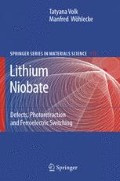Summary
Numerous publications on the polarization reversal and domain dynamics in LiNbO3 and LiTaO3 are summarized. First, the basics of the ferroelectric switching are discussed starting from the Landau-Guinzburg-Devonshire phenomenology with an account for a contribution from domains and domain walls. The concept of the internal bias fields Eb in ferroelectrics related to an interaction of defects with the host is presented. The Miller-Weinreich model of the ferroelectric switching is formulated and various techniques of studies in the ferroelectric switching and domain dynamics are drafted with an emphasis on those applicable to LiNbO3. The background part is closed by the basics of the optical frequency conversion using the ferroelectric domain structure. After a short historical review of the early results on the polarization reversal in LiNbO3 and of the first attempts of the creation of periodically poled LiNbO3 (PPLN), a specific of the ferroelectric P-E hysteresis loops in LiNbO3 and LiTaO3 is discussed. A drastic response of the coercive Ec and bias Eb fields and of the pulsed-switching parameters to an increase of the Li content or/and optical-damage-resistant impurity doping is described in detail. An interpretation of the polarization reversal specifics in terms of the pinning effects assuming the pinning centers to be the intrinsic defects is analyzed. In the next step an impact of a photoactive UV-light on the polarization reversal, particularly values of Ec and Eb and the switching velocity is presented which may be related to screening effects. In the end of the chapter, the experiments on recording regular domain patterns by means of electron and ion beams or under dc-voltages applied to AFM-tips are examined. These methods provide a possibility to obtain domain patterns on a nanoscopic level and to avoid the undesirable effects of back-switching and domain merging which are inherent for recording PPLNs by applying external fields to regular electrode patterns. A specific of the ferroelectric switching under an extremely spatially nonuniform field of an AFM-tip is characterized and current models are outlined.
Access this chapter
Tax calculation will be finalised at checkout
Purchases are for personal use only
Preview
Unable to display preview. Download preview PDF.
Rights and permissions
Copyright information
© 2008 Springer-Verlag Berlin Heidelberg
About this chapter
Cite this chapter
(2008). Polarization Reversal and Ferroelectric Domains in LiNbO3 Crystals. In: Lithium Niobate. Springer Series in Materials Science, vol 115. Springer, Berlin, Heidelberg. https://doi.org/10.1007/978-3-540-70766-0_7
Download citation
DOI: https://doi.org/10.1007/978-3-540-70766-0_7
Publisher Name: Springer, Berlin, Heidelberg
Print ISBN: 978-3-540-70765-3
Online ISBN: 978-3-540-70766-0
eBook Packages: Chemistry and Materials ScienceChemistry and Material Science (R0)

